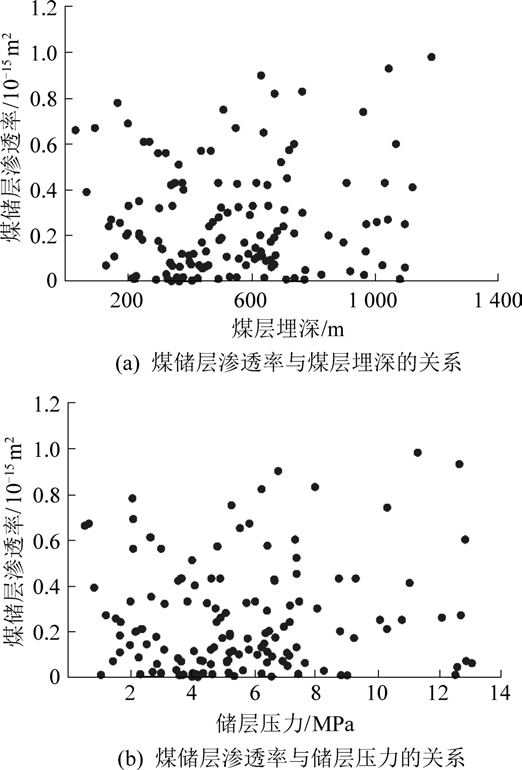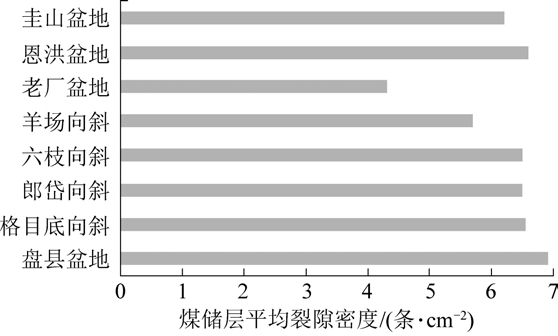
地球科学与测绘

Characteristics of present-day in-situ stress field and the Permian coal reservoir permeability in the eastern Yunnan and western Guizhou regions
随着油气勘探开发的不断深入,煤层气、页岩气以及致密油气等非常规油气在现有技术条件下显示出巨大潜力[1]。 煤层气作为一种重要的非常规油气资源,据第4 轮全国煤层气资源评价显示,全国埋深在2 000 m 以浅煤层气地质资源量为29.82×1012 m3,可采资源量为12.51×1012 m3[2]。 因此,如何实现煤层气的高效开发是目前面临的重要课题。准确预测一个地区的现今地应力状态不仅有助于非常规油气勘探开发[3-6],并且在CO2地质封存[7]、井壁稳定性评价[6,8-9]等方面也具有重要的作用。 研究表明,在煤层气勘探开发过程中,煤储层地应力可以通过控制压裂隙的形态和扩展方向影响煤储层的压裂改造效果,并能在排采过程中影响煤储层渗透率的动态变化,现今地应力状态(大小和方向)和煤储层渗透率是影响煤层气开发的重要地质因素[10-12]。 高产煤层气在地质方面表现为高渗透特征,而煤层渗透率的大小受到地应力、煤变质程度以及裂隙发育程度及方位等多因素控制[13-15]。 滇东-黔西地区二叠系煤储层富含大量煤层气资源[16]。基于此,依据试井及地应力测试参数对滇东-黔西地区现今地应力场和二叠系煤层渗透率开展研究,对该区煤层气的勘探开发具有重要的现实意义。
滇东-黔西地区位于中国西南部,面积2.58×104 km2,是黔西-滇东-川南晚二叠世上扬子聚煤沉积盆地的重要组成部分。 后期该区受燕山期、喜马拉雅期等多期构造运动的影响,造成原型盆地解体,形成现今众多的残留盆地[16](图1),这些聚煤(煤层气)盆地是我国长江以南著名的煤炭工业基地,同时也是我国重要的工业煤层气聚集场所,主要含煤层气盆地的总资源量可达2.2×1012 ~2.75×1012 m3,具有非常巨大的开发前景[16-17]。

图1 滇东-黔西地区煤层气盆地分布[16]
Fig.1 Distribution of coalbed methane basins in eastern Yunnan and western Guizhou regions[16]
滇东-黔西地区在晚二叠世发育了从陆相到海陆过渡相再到海相为主的沉积环境[18-19](图2)。按成因类型,研究区的含煤系地层可分为以典型宣威组为代表的陆相型与以龙潭组和长兴组为代表的海陆过渡相型。 滇东-黔西地区的工业煤层气主要赋存于海陆过渡相型中,如盘县盆地、格目底向斜、青山向斜、恩洪盆地、老厂-圭山盆地等[16]。 在垂向上,该区煤系最为显著的特征是多煤层叠置,煤层多而薄,以层序地层格架为主的沉积背景是其重要的控制因素[20]。

图2 滇东-黔西地区晚二叠世长兴阶沉积古地图图[18]
Fig.2 The Late Permian Changxing stage paleogeographic map in eastern Yunnan and western Guizhou regions[18]
目前而言,对于地应力状态的表征主要是依据地应力大小(包括水平最大主应力SH,max,水平最小主应力Sh,min和垂向应力Sv)和水平最大主应力方向[3-4,21]。 根据不同方向应力值之间的相互大小关系,可划分成3 种基本的应力机制类型[22](图3):正断应力机制(Sv >SH,max >Sh,min),走滑应力机制(SH,max >Sv >Sh,min)和逆断应力机制(SH,max>Sh,min>Sv)。

图3 地应力机制类型示意[21]
Fig.3 Types of in-situ stress regime[21]
现今地应力方向在油气勘探、开发和钻井工程中具有广泛应用。 一般而言,可以通过震源机制解反演、钻孔崩落特征、钻井诱导张裂隙特征、压裂隙微震监测等方法确定[6,9-10]。 研究主要依据最新的2016 版全球应力图(World Stress Map,WSM)数据库[23-24]进行现今地应力场方向的分析,结果显示,滇东-黔西地区水平最大主应力方向总体为WNW-ESE 向(图4)。

图4 滇东-黔西地区现今地应力场方向
Fig.4 The present-day in-situ stress orientations in eastern Yunnan and western Guizhou regions
水力压裂法是确定地应力的一种常用方法。 一般在煤层气井投入生产之前,需要参照中国国家标准GB/T 24504—2009 对煤层开展/压降试井,参照中国行业标准DB/T 14—2000 进行原地应力测试,以获取煤层渗透率、储层压力、闭合压力以及破裂压力等参数。 结果表明,滇东-黔西地区二叠系煤层埋深在31.77 ~1 182.64 m 内;煤层破裂压力为2.01~29.16 MPa,平均为11.55 MPa;闭合压力为1.85~23.76 MPa,平均为10.36 MPa;煤储层压力为0.52~12.81 MPa,平均为5.44 MPa(表1)。
表1 滇东-黔西地区二叠系煤储层水力压裂试验参数统计
Table 1 Hydraulic fracture parameters in the Permian coal reservoirs of eastern Yunnan and western Guizhou regions

测试参数测试结果(最小值~最大值)/平均值煤层埋藏深度/m(31.77~1182.64)/536.58破裂压力/MPa(2.01~29.16)/11.55破裂压力梯度/(kPa·m-1)(12.9~63.3)/23.3闭合压力/MPa(1.85~23.76)/10.36闭合压力梯度/(kPa·m-1)(12.4~58.2)/20.6煤储层压力/MPa(0.52~12.81)/5.44煤储层压力梯度/(kPa·m-1)(4.7~17.1)/10.1
在煤储层参数获取的基础上,一般认为闭合压力即等于测试深度处的水平最小主应力[9],即:
式中:Sh,min 为水平最小主应力,MPa;Pc 为闭合压力,MPa。水平最大主应力可依据下式计算[25]:
SH,max =3 Sh,min - Pf - Po + T(2)式中:Pf为破裂压力,MPa;Po为储层压力,MPa;T 为煤岩抗拉强度,MPa。
而对于垂向应力,可依据上覆岩石重力计算,即:
式中:μ 为岩石容重,计算时可参考取μ =0.027[26];h 为上覆岩体厚度,m。
在研究过程中,由于煤岩石力学样品制备困难等问题尚无法获取每处压裂深度点的煤岩抗拉强度,再者煤岩的抗拉强度相对较低,忽略不计时对结果影响较小,因此,在计算水平最大主应力时主要依据下式进行:
根据滇东-黔西地区138 组二叠系煤层水力压裂试验参数,计算研究区水平最大主应力为2.67 ~29.84 MPa,平均为14.10 MPa;水平最小主应力为1.85~23.76 MPa,平均为10.36 MPa;垂向应力为0.86~31.93 MPa,平均为14.49 MPa。
随着地质环境的变化致使所计算出来的地应力分布具有差异性,但滇东-黔西地区二叠系煤层地应力大小随埋深的分布仍具有某些规律:
1)煤层地应力大小随着埋深表现出较好的正相关性(图5)。 水平最大主应力、水平最小主应力和垂向应力的大小均随着煤层埋深的增大而具有增大的趋势。
2)煤层地应力的垂向分布具有分带性(图5)。根据应力机制的垂向变化,可划分为三个带,即:(Ⅰ)浅部带,在600 m 以浅,研究区地应力分布整体表现为SH,max >Sv >Sh,min,水平最大主应力起主导作用,为大地动力场型。 (Ⅱ)过渡带,在600 ~700 m,地应力的垂向分布呈现多种形式,水平最大主应力和垂向应力交替起主导作用。 (Ⅲ) 深部带,深度超过700 m 之后,研究区地应力机制转换为Sv>SH,max >Sh,min,垂向应力起主导作用,为大地静力场型。 因此,滇东-黔西地区的地应力垂向转换深度为600~700 m。

图5 滇东-黔西地区地应力垂向分布特征
Fig.5 Vertical distribution of in-situ stresses in eastern Yunnan and western Guizhou regions
统计表明,滇东-黔西地区二叠系煤层渗透率主要介于0.000 2 ~0.98×10-15 m2,分布范围较大。由于在不同具体区块各种因素的影响,二叠系煤层渗透率呈现不规则变化,整体规律性不明显。 迄今,国内外诸多含煤盆地针对煤层现今地应力场和煤储层渗透率开展了一系列卓有成效的研究[3-4,10-12,27-28],认为煤储层渗透率很大程度上受现今地应力场的影响。 一般而言,煤储层中有效地应力(即原地应力与储层压力之差)的变化会造成煤体变形,进而导致煤储层渗透率发生变化,在其他影响因素均等时,煤储层渗透率随着有效地应力的增大而呈指数减小[1-12,27,29]。 但在滇东-黔西地区,二叠系煤储层渗透率与有效地应力间并没有表现出良好的指数关系(图6),表明研究区二叠系煤储层渗透率变化复杂,受多种因素综合控制。

图6 滇东-黔西地区二叠系煤储层渗透率与有效地应力关系
Fig.6 The relationship between coal permeability and effective in-situ stresses in the Permian coal reservoirs of eastern Yunnan and western Guizhou regions
煤储层是裂隙-孔隙型储集层,属于低孔低渗非常规储层,煤储层渗透率的高低除了受地应力影响外,还取决于煤化作用程度、天然裂隙、煤层埋深、煤体结构以及储层压力等方面[13,27,30-31]。 滇东-黔西地区二叠系煤储层埋深、储层压力与渗透率之间的关系表明,二者之间也不存在明显的相关性(图7)。 天然裂隙的发育程度与产状对煤储层、致密油储层等非常规储层的渗透性具有重要的控制作用[27,32-34]。 煤储层中发育的天然裂隙不仅可作为煤层气重要的储集空间,同时也能良好地连通煤基质之间的空隙网络,有效增强煤储层的渗透性[34]。滇东-黔西地区二叠系煤层沉积后经历了印支期、燕山期以及喜马拉雅期多期构造运动,发育复杂且相互交织的断层和裂隙系统[16]。 据统计[34],滇东-黔西地区二叠系煤储层裂隙发育,平均裂隙密度在4.30 ~6.92 条/cm2内,盘县盆地二叠系煤储层的平均裂隙密度高达6.92 条/cm2(图8)。

图7 滇东-黔西地区二叠系煤储层渗透率与煤层埋深和储层压力之间关系
Fig.7 The relationship among coal permeability, burial depth and reservoir pressure in the Permian coal reservoirs of eastern Yunnan and western Guizhou regions

图8 滇东-黔西地区二叠系煤储层平均裂隙密度
Fig.8 The average fracture density in the Permian coal reservoirs of eastern Yunnan and western Guizhou regions
另外,依据煤层裂隙产状实测统计,滇东-黔西地区二叠系煤储层主要发育高角度裂隙,裂隙倾角主要集中在65°~85°。 同时,前文地应力分析显示,滇东-黔西地区的深部带(即深度超过700 m 时)煤储层的应力机制为Sv >SH,max >Sh,min。 在这种垂向应力主导作用下,高角度裂隙多呈开启状态(图3),进而可有效增大煤储层渗透率。
滇东-黔西地区二叠系煤储层渗透率变化受多种因素综合影响,单一的煤层埋深、储层压力等因素对研究区渗透率的控制不明显,天然裂隙状态及其与现今地应力场耦合可能是控制研究区二叠系煤层渗透率的重要因素。
1)滇东-黔西地区水平最大主应力方向总体为WNW-ESE 向。
2)滇东-黔西地区二叠系煤层破裂压力为2.01~29.16 MPa,平均为11.55 MPa;闭合压力为1.85~23.76 MPa,平均为10.36 MPa;煤储层压力为0.52~12.81 MPa,平均为5.44 MPa。 水平最大主应力为2.67~29.84 MPa,平均为14.10 MPa;水平最小主应力为1.85~23.76 MPa,平均为10.36 MPa;垂向应力为0.86~31.93 MPa,平均为14.49 MPa。
3)滇东-黔西地区现今地应力大小随煤层埋深的增加而增大,在垂向分布上呈现出分带性。 在600 m 以浅,地应力分布整体表现为SH,max >Sv >Sh,min,水平最大主应力起主导作用;深度超过700 m之后,地应力机制转换为Sv >SH,max >Sh,min,垂向应力起主导作用,为大地静力场型;地应力垂向转换深度为600~700 m。
4)滇东-黔西地区二叠系煤储层渗透率的变化受多种因素的综合影响。 煤层埋深、储层压力、有效地应力等因素对研究区二叠系煤储层渗透率变化的控制不明显,天然裂隙特征(发育程度与产状)及其与现今地应力状态(地应力大小和方向)的配套关系可能对该区煤储层渗透性起到重要控制作用。
致谢:感谢评审专家提出的建设性宝贵意见。云南省198 煤田地质勘探队为本次研究给予大力帮助,特此致谢!
[1] 贾承造, 郑 民, 张永峰. 中国非常规油气资源与勘探开发前景[J]. 石油勘探与开发,2012,39(2):129-136.JIA C Z,ZHENG M,ZHANG Y F,2012. Unconventional hydrocar⁃bon resources in China and the prospect of exploration and devel⁃opment [J]. Petroleum Exploration and Development, 2012,39(2):129-136.
[2] 庚 勐,陈 浩,陈艳鹏,等. 第4 轮全国煤层气资源评价方法及结果[J]. 煤炭科学技术,2018,46(6):64-68.GENG M,CHEN H,CHEN Y P,ZENG L J,2018. Methods and results of the fourth round national CBM resources evaluation [J].Coal Science and Technology,2018,46(6):64-68.
[3] BELL,J S. In-situ stress and coal bed methane potential in Western Canada [J]. Bulletin of Canadian Petroleum Geology,2006,54:197-220.
[4] TINGAY M R P,HILLS R R,MORLEY C K,et al. Present-day stress and neotectonics of Brunei:Implications for petroleum explo⁃ration and production [J]. American Association of Petroleum Ge⁃ologists Bulletin,2009,93(1):75-100.
[5] 姜 波,汪吉林,屈争辉,等.大宁-吉县地区地应力特征及其对煤储层渗透性的影响[J]. 地学前缘,2016,23(3):17-23.JIANG B,WANG J L,QU Z H,et al. The stress characteristics of the Daning-Jixian Area and its influence on the permeability of the coal reservoir [J]. Earth Science Frontiers,2016,23(3):17-23.
[6] JU W,SHEN J,QIN Y,et al. In-situ stress state in the Linxing re⁃gion,eastern Ordos Basin,China:Implications for unconventional gas exploration and production [ J]. Marine and Petroleum Geology,2017,86:66-78.
[7] BUSTIN R M,CUI X,CHIKATAMARL L. Impacts of volumetric strain on CO2 sequestration in coals and enhanced CH4 recovery[J]. American Association of Petroleum Geologists Bulletin,2008,92:15-29.
[8] RAJABI M,TINGAY M R P,HEIDBACH O. The present-day state of tectonic stress in the Darling Basin,Australia:Implications for exploration and production [ J]. Marine and Petroleum Geology,77:776-790.
[9] ZOBACK M D,BARTON C A,BRUDY M,et al. Determination of stress orientation and magnitude in deep wells [J]. International Journal of Rock Mechanics and Mining Sciences,2003,40:1049-1076.
[10] 孟召平,蓝 强,刘翠丽,等. 鄂尔多斯盆地东南缘地应力、储层压力及其耦合关系[J]. 煤炭学报,2013,38(1):122-128.MENG Z P,LAN Q,LIU C L,et al. In-situ stress and coal reser⁃voir pressure in southeast margin of Ordos Basin and their coupling relations [J]. Journal of China Coal Society,2013,38(1):122-128.
[11] LI Y,TANG D Z,XU H,et al. In-situ stress distribution and its implication on coalbed methane development in Liulin area,eastern Ordos Basin,China [J]. Journal of Petroleum Science and Engineering,122:488-496.
[12] ZHAO J L,TANG D Z,XU H,et al. Characteristic of in situ stress and its control on the coalbed methane reservoir permeability in the eastern margin of the Ordos Basin,China[J].Rock Mechanics and Rock Engineering,2016,49:3307-3322.
[13] 叶建平,史保生,张春才,中国煤储层渗透性及其主要影响因素[J]. 煤炭学报,1999,24(2):118-122.YE J P,SHI B S,ZHANG C C. Coal reservoir permeability and its controlled factors in China[J]. Journal of China Coal Society,1999,24(2):118-122.
[14] 宋 岩,柳少波,琚宜文,等. 含气量和渗透率耦合作用对高丰度煤层气富集区的控制[J]. 石油学报,2013,34(3):417-426.SONG Y,LIU S B,JU Y W,et al. Coupling between gas content and permeability controlling enrichment zones of high abundance coalbed methane [J]. Acta Petrolei Sinica,2013,34(3):417-426.
[15] 李 松,汤达祯,许 浩,等. 应力条件制约下不同埋深煤储层物性差异演化[J]. 石油学报,2015,36(S1):68-75.LI S,TANG D Z,XU H,et al. Evolution of physical differences in various buried depth of coal reservoirs under constraint of stress[J]. Acta Petrolei Sinica,2015,36(S1):68-75.
[16] 桂宝林,黔西滇东煤层气地质与勘探[M]. 昆明:云南科技出版社,2001,215.
[17] 陶 树,汤达祯,秦 勇,等.黔西滇东典型矿区含煤地层热演化史分析[J]. 煤田地质与勘探,2010,38(6):17-21.TAO S,TANG D Z,QIN Y,et al. Analysis on thermal history of coal strata of typical mining areas in western Guizhou and eastern Yunnan [J]. Coal Geology and Exploration,2010,38(6):17-21.
[18] 汪 浩,滇 东、黔西晚二叠世煤的沉积学特征及古环境意义[D]. 北京:中国矿业大学(北京),2011:132.WANG Hao. Sedimentological characteristics and palaeoenviron⁃mental bearings of the Late Permian coals in eastern Yunnan and western Guizhou of southwestern China [D].Beijing:China Uni⁃versity of Mining and Technology-Beijing,Beijing,2011:132.
[19] 王小川. 黔西川南滇东晚二叠世含煤地层沉积环境与聚煤规律[M]. 重庆:重庆大学出版社,1996,296.
[20] 陈贞龙. 黔西滇东地区煤层气富集规律及流体作用研究[D].北京:中国地质大学(北京),2010:72.CHEN Z L. Study on the accumulation of coalbed methane and action of fluid in western Guizhou and eastern Yunnan [D].Bei⁃jing: China University of Geosciences ( Beijing), Beijing,2010:72.
[21] BROOKE-BARNETT S,FLOTTMANN T,Paul P K,et al. Influ⁃ence of bas⁃ement structures on in situ stresses over the Surat Ba⁃sin,southeast Queensland [J]. Journal of Geophysical Research:Solid Earth,2015,120:1-20.
[22] ANDERSON E M.The Dynamics of Faulting and Dyke Formation with Applications to Britain ( second version) [ M]. Oliver,Edinburgh,1951.
[23] HEIDBACH O,RAJABI M,REITER K,etal.World stress map database release 2016[R].GFZ Data Services,https:/ /doi.org/10.5880/WSM.2016.001.
[24] HEIDBACH O,RAJABI M,REITER K,etal.World stress map 2016[R]. GFZ Data Services, https:/ /doi. org/10. 5880/WSM.2016.002.
[25] HUBBERT M K,WILLIS D G. Mechanics of hydraulic fracturing[J]. Petroleum Transactions,The American Institute of Mining,Metallurgical,and Petroleum Engineers,1957,210:153-168.
[26] BROWN E T,HOEK E. Trends in relationships between measured in situ stresses and depth [J]. International Journal of Rock Me⁃chanics and Mining Sciences and Geomechanics Abstracts,1978,15:211-215.
[27] 孟召平,田永东,李国富. 沁水盆地南部煤储层渗透性与地应力之间关系和控制机理[J]. 自然科学进展,2009,19(10):1142-1148.MENG Z P,TIAN Y D,LI G F. The relationship and mechanism between in-situ stress and coal reservoir permeability in the southernQinshui Basin [J]. Advances in Natural Science,2009,19(10):1142-1148.
[28] 秦 勇,张德民,傅雪海,等. 山西沁水盆地中、南部现代构造应力场与煤储层物性关系之探讨[J]. 地质论评,1999,45(6):576-583.QIN Y,ZHANG D M,FU X H,Lin D Y,et al.A discussion on correlation of modern tectonic stress field to physical propertiesof coal reservoirs in central and southern Qinshui Basin [J]. Geo⁃logical Review,1999,45(6):576-583.
[29] ENEVER J R E,HENNING A. The relationship between permea⁃bility and effective stress for Australian coal and its implications with respect to coalbed methane exploration and reservoir modeling [C]/ /Proceedings of the 1997 International Coalbed Methane Symposium,1997:13-22.
[30] MCKEE C R,BUMB A C,Koenig R A.Stress-dependent permea⁃bility and porosity of coal and other geologic formations [J]. So⁃ciety of Petroleum Engineers Formation Evaluation,1988,3(1):81-91.
[31] 傅雪海,秦 勇,李贵中. 沁水盆地中-南部煤储层渗透率主控因素分析[J]. 煤田地质与勘探,2001,29(3):16-19.FU X H,QIN Y,LI G Z. An analysis on the principal control fac⁃tor of coal reservoir permeability in central and southernQinshui Basin [J]. Coal Geology and Exploration,2001,29(3):16-19.
[32] JU W,SUN W F. Tectonic fractures in the Lower Cretaceous Xiagou Formation of Qingxi Oilfield,Jiuxi Basin,NW China. Part two:Numerical simulation of tectonic stress field and prediction of tec⁃tonic fractures [ J ]. Journal of Petroleum Science and Engineering,2016,146:626-636.
[33] AYDIN A. Fracture,faults,and hydrocarbon entrapment,migration and flow [J]. Marine and Petroleum Geology,2000,17:797-814.
[34] 顾成亮,桂宝林. 滇东-黔西地区晚二叠世煤层割理研究及其在煤层气勘探中的意义[J]. 云南地质,2000,19(4):352-362.GU C L,GUI B L. A study on the Upper Permian coalbed cleat in east Yunnan and west Guizhou and its significance[J]. Yunnan Geology,2000,19(4):352-362.